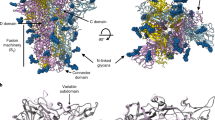Summary
The antigenic properties of influenza C viral glycoprotein gp88 were compared with those of its nonglycosylated counterpart T76 synthesized in infected cells treated with tunicamycin. Radioimmunoprecipitation experiments with three different monoclonal antibodies against gp88 revealed that an antibody designated Q-5 precipitated gp88 but not T76, indicating the requirement for glycosylation for the binding of this antibody to gp88. It is unlikely, however, that the antigenic determinant recognized by Q-5 is carbohydrate moiety since the ability of the antibody to bind to gp88 varied depending on the virus strain, and trypsin-treatment of gp88 eliminated its reactivity with Q-5. Gel electrophoretic analysis under nonreducing conditions showed that T76 underwent the formation of disulfidelinked multimers in the absence of reducing agent while gp88 behaved as monomers, suggesting that glycosylation is required for gp88 molecules to attain an appropriate conformation. These observations, altogether, suggests that glycosylation is important in determining the immunological specificity of gp88 presumably by influencing the folding of this glycoprotein.
Similar content being viewed by others
References
Air, G. M., Compans, R. W.: Influenza B and influenza C viruses. In:Palese, P., Kingusbury, D. W. (eds.), Genetics of Influenza Viruses, 280–304. Wien-New York, Springer 1983.
Basak, S., Compans, R. W.: Studies on the role of glycosylation in the functions and antigenic properties of influenza virus glycoproteins. Virology128, 77–91 (1983).
Bonner, W. M., Laskey, R. A.: A film detection method for tritium-labelled proteins and nucleic acids in polyacrylamide gels. Eur. J. Biochem.46, 83–88 (1974).
Caliguiri, L. A., Tamm, I.: The role of cytoplasmic membranes in poliovirus biosynthesis. Virology42, 100–111 (1970).
Compans, R. W., Klenk, H.-D., Caliguiri, L. A., Choppin, P. W.: Influenza virus proteins. I. Analysis of polypeptides of the virion and identification of spike glycoproteins. Virology42, 880–889 (1970).
Gibson, R., Schlesinger, S., Kornfeld, S.: The nonglycosylated glycoprotein of vesicular stomatitis virus is temperature-sensitive and undergoes intracellular aggregation at elevated temperatures. J. Biol. Chem.254, 3600–3607 (1979).
Gitelman, A. K., Berezin, V. A., Kharitonenkov, I. G.: The role of carbohydrate in determining the immunochemical properties of the hemagglutinin of influenza A virus. Arch. Virol.67, 253–266 (1981).
Herrler, G., Compans, R. W., Meier-Ewert, H.: A precursor glycoprotein in influenza C virus. Virology99, 49–56 (1979).
Hirst, G. K.: The relationship of the receptors of a new strain of virus to those of the mumps-NDV-influenza group. J. Exp. Med.91, 177–184 (1950).
Hongo, S., Sugawara, K., Homma, M., Nakamura, K.: The functions of oligo-saccharide chains associated with influenza C viral glycoproteins. I. The formation of influenza C virus particles in the absence of glycosylation. Arch. Virol.89, 171–187 (1986).
Kaluza, G., Rott, R., Schwarz, R. T.: Carbohydrate-induced conformational changes of Semliki Forest virus glycoproteins determine antigenicity. Virology102, 286–299 (1980).
Kendal, A. P.: A comparison of “influenza C” with prototype myxoviruses: Receptor-destroying activity (Neuraminidase) and structural polypeptides. Virology65, 87–99 (1975).
Klenk, H.-D., Wollert, W., Rott, R., Scholtissek, C.: Association of influenza virus proteins with cytoplasmic fractions. Virology57, 28–41 (1974).
Köhler, G., Milstein, C.: Derivation of specific antibody-producing tissue culture and tumor lines by cell fusion. Eur. J. Immunol.6, 511–519 (1976).
Laemmli, U. K.: Cleavage of structural proteins during the assembly of the head of bacteriophage T 4. Nature (London)227, 680–685 (1970).
Nakamura, K., Compans, R. W.: Effects of glucosamine, 2-deoxyglucose, and tunicamycin on glycosylation, sulfation, and assembly of influenza viral proteins. Virology84, 303–319 (1978).
Nakamura, K., Herrler, G., Petri, T., Meier-Ewert, H., Compans, R. W.: Carbohydrate components of influenza C virions. J. Virol.29, 997–1005 (1979).
Nakamura, K., Homma, M., Compans, R. W.: Effect of tunicamycin on the replication of Sendai virus. Virology119, 474–487 (1982).
Nakamura, K., Kitame, F., Homma, M.: A comparison of proteins among various influenza B virus strains by one-dimensional peptide mapping. J. gen. Virol.56, 315–323 (1981).
Olden, K., Pratt, R. M., Yamada, K. M.: Role of carbohydrates in protein secretion and turnover: Effects of tunicamycin on the major cell surface glycoprotein of chick embryo fibroblasts. Cell13, 461–473 (1978).
Pouysséqur, J., Yamada, K. M.: Isolation and immunological characterization of a glucose-regulated fibroblast cell surface glycoprotein and its nonglycosylated precursor. Cell13, 139–150 (1978).
Schafer, W., Fischinger, P. J., Collins, J. J., Bolognesi, D. P.: Role of carbohydrate in biological functions of Friend murine leukemia virus gp 71. J. Virol.21, 35–40 (1977).
Scheid, A., Choppin, P. W.: Isolation and purification of the envelope proteins of Newcastle disease virus. J. Virol.11, 263–271 (1973).
Schwarz, R. T., Rohrschneider, J. M., Schmidt, M. F.: Suppression of glycoprotein formation of Semliki forest, influenza, and avian sarcoma virus by tunicamycin. J. Virol.19, 782–791 (1976).
Sugawara, K., Ohuchi, M., Nakamura, K., Homma, M.: Effects of various proteases on the glycoprotein composition and the infectivity of influenza C virus. Arch. Virol.68, 147–151 (1981).
Van Eldik, L. J., Paulson, J. C., Green, R. W., Smith, R. E.: The influence of carbohydrate on the antigenicity of the envelope glycoprotein of avian myeloblastosis virus and B77 avian sarcoma virus. Virology86, 193–204 (1978).
Yokota, M., Nakamura, K., Sugawara, K., Homma, M.: The synthesis of polypeptides in influenza C virus-infected cells. Virology130, 105–117 (1983).
Author information
Authors and Affiliations
Additional information
With 5 Figures
Presented in part at the international meeting of influenza virus hemagglutinin, Miki, Japan (September 7–9, 1984).
Rights and permissions
About this article
Cite this article
Hongo, S., Sugawara, K., Homma, M. et al. The functions of oligosaccharide chains associated with influenza C viral glycoproteins. Archives of Virology 89, 189–201 (1986). https://doi.org/10.1007/BF01309888
Received:
Accepted:
Issue Date:
DOI: https://doi.org/10.1007/BF01309888




